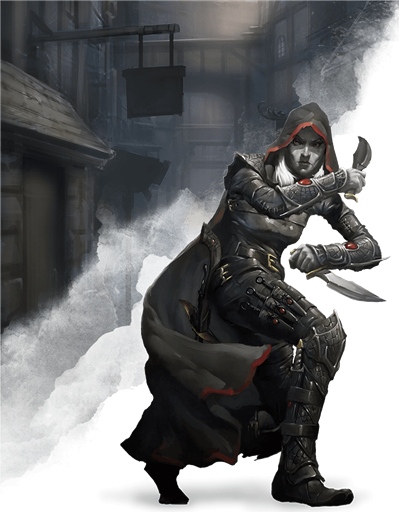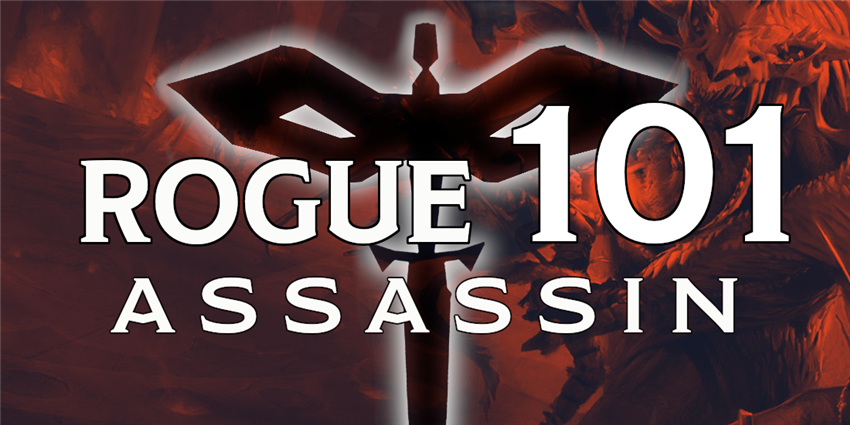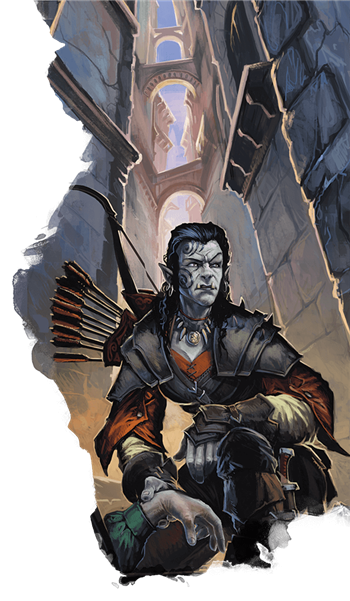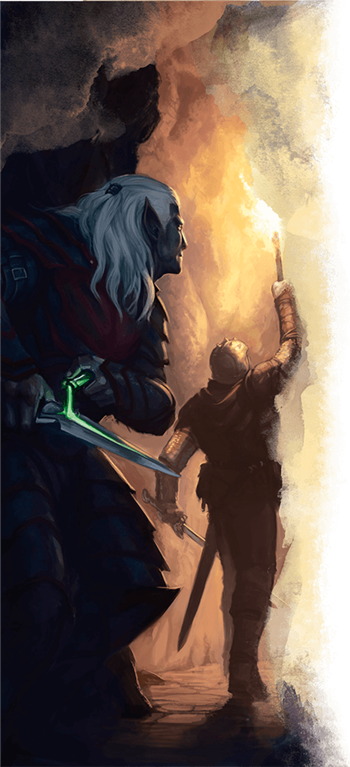 Class is back in session. This week, walk with silent footfalls and carry only weapons small enough to conceal until they appear mysteriously between our enemies’ ribs. Few mortal beings can deal as much damage in a single turn as a rogue who practices the art of assassination—but the act of killing with a single blow requires special preparation, and a DM who weaves scenarios where you can attack from surprise.
Class is back in session. This week, walk with silent footfalls and carry only weapons small enough to conceal until they appear mysteriously between our enemies’ ribs. Few mortal beings can deal as much damage in a single turn as a rogue who practices the art of assassination—but the act of killing with a single blow requires special preparation, and a DM who weaves scenarios where you can attack from surprise.
We’ve completed our first full rotation of the twelve classes, and exhausted all the content that the Basic Rules have to offer—as far as classes go, that is. This next wave of the Class 101 series will appraise every subclass within the Player’s Handbook and break down each subclass’s strengths, weaknesses, thematic elements, and everything else a player would want to know before playing that subclass. Because of this, you will need to own the Player’s Handbook (or purchase the subclass a la carte on the Marketplace) in order to make full use of this series.
Check out the other guides in the Class 101 series, like the broad overview of the rogue class in Rogue 101: A Beginner’s Guide to Stealth and Subterfuge, and Rogue 101: Thief. If you’re interested in playing other classes, check out the entire Class 101 series.
Story of the Assassin
An assassin waited upon a rooftop in a small farming village. She perched behind a chimney, staring at the windows of a small country inn. A harvest moon hung overhead, and the only sound in the air was that of a rusty vane creaking in the wind. After months of searching, weeks of disguises, and countless insufferable hours of favors and honeyed words, she had found him. Her eyes narrowed, and she peered into his window. The yellow glow of his room’s lamp filtered through his curtained window onto the snow. He’s not above the ground floor, she thought. Arrogant bastard.
Then the lamplight flickered out. The assassin smiled. She leapt from rooftop to rooftop, until she reached the inn her target was hiding in. She clambered quietly down the gutterpipe and set one foot deftly on his windowsill. No trace would be left in the snow beneath his room. Not a trace of her murder would be found—save the ultimate proof.
She opened the window. The room was silent. Less than a minute later, she left, and was never seen in that village again. The next day, the target never left his room. He had told the innkeeper that he was to remain undisturbed when he bought the room, and so no maid came to bother him. It wasn’t until the stench came wafting out a week later that someone dared enter. And by that time, the assassin was over a hundred miles away, never to be found.
Assassin Features
Rogues trained in the art of assassination are renowned for the ability to deal massive damage to unsuspecting foes—but that’s not the only trick they have up their sleeves. The rogue gains access to four subclass features, but many of them skew late. Though you gain access to the first at 3rd, you must wait until 9th for your next, with your final two features eventually coming at 13th and 17th level. You can read all of the Assassin features in the Player’s Handbook. In summary, your subclass features allow you to:
- Deliver lethal blows to unsuspecting enemies.
- Create a false identity to help you infiltrate your target’s defenses.
- Study another person’s behavior to mimic their mannerisms.
- Deliver even more deadly strikes to unsuspecting enemies.

Benefits of the Assassin Archetype
In terms of combat abilities, the assassin is an incredibly straightforward archetype: attack your enemies before they have the chance to attack you—especially if they don’t even know you’re there. Your best turn in combat will invariably be the first turn. After that, you act more or less exactly like any other rogue, unless there are other foes that you can try to surprise and assassinate before they’re aware that a fight’s broken out.
The Assassinate feature, which you gain at 3rd level, seems remarkably powerful on the surface. While it is legitimately powerful, it does have some confusing wording that can lead you to believe it’s more vicious than it actually is. This relates to its “automatic critical hit” effect, which doubles all dice in your attack—including Sneak Attack dice. An attack is only an automatic critical if the creature you’re attacking is surprised. This means that the creature CAN’T be aware of your presence, or that a fight is happening at all. Surprise only happens at the start of a combat encounter, and only when someone in combat is totally unaware of any of their attackers.
Beyond your combat abilities, the assassin gets a suite of social abilities that can give you total mastery in the art of disguise and deception. Your Infiltration Expertise and Imposter traits are both broad in scope, allowing you to fabricate false identities and even assume the identity of someone else. Beyond simply assuming someone’s appearance, like what a changeling might do, these traits allow you to believably mimic this person’s mannerisms and even their handwriting, allowing you to forge documents. These traits are incredibly powerful in an intrigue-focused campaign where words and letters are just as powerful as swords and spells.
Drawbacks of the Assassin Archetype
 The Assassin archetype’s greatest noncombat strength is, ironically, also its greatest weakness. The Infiltration Expertise and Imposter class features are potent in the right circumstances, but have precious little use outside of that particular niche. In campaigns with straightforward villains to whom intrigue isn’t important—that is, if your campaign is more Infinity War than James Bond—then this features won’t do you much good. Creative rogues may be able to squeeze some use out of them, but these features really rely on your Dungeon Master setting the stage for them to be useful.
The Assassin archetype’s greatest noncombat strength is, ironically, also its greatest weakness. The Infiltration Expertise and Imposter class features are potent in the right circumstances, but have precious little use outside of that particular niche. In campaigns with straightforward villains to whom intrigue isn’t important—that is, if your campaign is more Infinity War than James Bond—then this features won’t do you much good. Creative rogues may be able to squeeze some use out of them, but these features really rely on your Dungeon Master setting the stage for them to be useful.
You may be able to ask your DM to involve elements of intrigue that suit your subclass. Howeveryou’re your DM is unwilling to bend their campaign arc, or if you like assassinating enemies but just aren’t that interested in subterfuge, then you may want to multiclass. Rogues uninterested in making false identies often choose to multiclass after reaching 8th level in the rogue class, before they gain their 9th-level subclass feature. Good potential multiclassing options include fighter (both Champion and Battle Master are useful), monk (particularly if you want to follow the Way of Shadows), or—if you want to make a more unusual choice—cleric (following a domain like Knowledge or Trickery) or sorcerer (with the Shadow Magic bloodline from Xanathar’s Guide to Everything) can be exciting choices.
Suggested Build
Like most classes in D&D, the rogue doesn’t choose their subclass until 3rd level. If you’re playing a rogue from 1st level and think you want to become an Assassin later, you should choose a race that improves your Dexterity score. If you plan on creating false identities, then consider making Charisma your next-best feature. If you’re uninterested in subterfuge and would prefer assassinating monsters in dungeons, making either Intelligence (to improve your Investigation abilities) or Wisdom (to improve your Perception abilities) your second-highest ability score would be wise.
Wood elves, dark elves, and lightfoot halflings make excellent assassins, thanks to their bonuses to both Dexterity and Wisdom, and because they have racial traits that make it easy for them to hide in plain sight. Forest gnomes make surprisingly good assassins, thanks to their bonuses to both Dexterity and Intelligence, and their ability to cast minor illusion at will. Half-elves can be suave and charismatic assassins, and humans are flexible people who can adapt to just about any calling—especially if you play a variant human with the Skulker feat.
As usual, your character’s background is up to you. You can come up with all sorts of interesting stories and oddball characters by pairing unlikely backgrounds with the Assassin archetype. Are you a personable and charming assassin, who prefers to observe opponents over a game of Three-Dragon Ante while sipping a shaken-not-stirred martini? The Folk Hero or Charlatan backgrounds would serve you well. Or are you a silent and stoic killer, bred by war or wilderness? The Soldier or Outlander backgrounds might fit you.
It’s a safe bet to choose EQUIPMENT when given the choice between GOLD or EQUIPMENT during character creation. As long as you have a weapon with the Finesse trait (such as a rapier, short sword, or dagger), you practically have a license to kill. Daggers may not deal a lot of damage, but their small size allows them to be easily concealed. This is much more useful than a few extra points of damage—especially since your Sneak Attack and Assassinate features are really where your damage will be coming from, not your weapon’s innate damage die. If you plan on infiltrating residences, then a burglars’ pack will help you. Otherwise, choose a dungeoneer’s pack.
Feats
 At 4th level, you get to gain either an Ability Score Increase or a feat. Choosing an Ability Score Increase lets you increase one ability score by +2 (such as increasing your Dexterity score from 16 to 18) or increase two ability scores by +1 (like increasing your Dexterity from 15 to 16 and your Wisdom score from 13 to 14). Increasing your ability scores makes you better at a wide variety of things; for instance, increasing your Dexterity score makes it easier to hit with your weapon attacks, and it also makes it harder for enemies to hit you, while also making you more likely to succeed on Dexterity saving throws and make successful Dexterity checks.
At 4th level, you get to gain either an Ability Score Increase or a feat. Choosing an Ability Score Increase lets you increase one ability score by +2 (such as increasing your Dexterity score from 16 to 18) or increase two ability scores by +1 (like increasing your Dexterity from 15 to 16 and your Wisdom score from 13 to 14). Increasing your ability scores makes you better at a wide variety of things; for instance, increasing your Dexterity score makes it easier to hit with your weapon attacks, and it also makes it harder for enemies to hit you, while also making you more likely to succeed on Dexterity saving throws and make successful Dexterity checks.
Feats, on the other hand, give you a special ability that could be more helpful in a specific circumstance, as opposed to the broad improvement that an Ability Score Increase could give you. Dexterity is your most important ability score, since it governs your ability to hit with attacks. Once you’ve increased your Dexterity score to 20 (its maximum value), or even just to 18 (a pretty good value), you may want to choose a feat. You can choose any feat you want to support your character concept, but there are some feats that may be more useful to your character than others.
Alert. You are a character that loves to go first in combat, since your Assassinate feature gives you advantage on attacks against creatures that haven’t acted yet.
Actor. If you don’t want to invest too much in Charisma, this gives you some very specific abilities that complement your suite of social impersonation features.
Inspiring Leader. An odd choice, but if you’ve invested in your Charisma score, this is a good way to be more of a team player by inspiring your party.
Sentinel. Don’t forget, you get one use of Sneak Attack per turn—not per round, per turn. This means you can Sneak Attack on your turn, and then use your reaction on an enemy’s turn to attack again, potentially getting Sneak Attack. This is most useful when you coordinate with your allies to ensure that they’re always in position to help you get Sneak Attack.
Sharpshooter. If you want to assassinate your targets from range (and really, why wouldn’t you?), this feat cranks your already incredible damage output up to 11. Take care with this, though. Since you only have one attack per turn, sometimes you just want to hit in order to activate your Sneak Attack damage. Taking a –5 penalty to hit and then missing isn’t always worth the potential to gain an extra +10 damage.
Skulker. Being able to shoot without giving away your position is incredibly useful. The other benefits are nice, too.
If you want more advice for building a rogue, check out Rogue 101. Have you ever played an Assassin? What advice would you give to players that want to play this subclass?
 James Haeck is the lead writer for D&D Beyond, the co-author of Waterdeep: Dragon Heist, Baldur's Gate: Descent into Avernus, and the Critical Role Tal'Dorei Campaign Setting, a member of the Guild Adepts, and a freelance writer for Wizards of the Coast, the D&D Adventurers League, and other RPG companies. He lives in Seattle, Washington with his fiancée Hannah and their animal companions Mei and Marzipan. You can find him wasting time on Twitter at @jamesjhaeck.
James Haeck is the lead writer for D&D Beyond, the co-author of Waterdeep: Dragon Heist, Baldur's Gate: Descent into Avernus, and the Critical Role Tal'Dorei Campaign Setting, a member of the Guild Adepts, and a freelance writer for Wizards of the Coast, the D&D Adventurers League, and other RPG companies. He lives in Seattle, Washington with his fiancée Hannah and their animal companions Mei and Marzipan. You can find him wasting time on Twitter at @jamesjhaeck.








-
View User Profile
-
Send Message
Posted Dec 6, 2019I have never considered Sentinel on a rogue. This is actually brilliant.
-
View User Profile
-
Send Message
Posted Dec 6, 2019Oh, god, comboing it with the swashbuckler, so you can be 1v1ing someone and still get sneak attack... Isolate a single target and sneak attack them to death, much?
-
View User Profile
-
Send Message
Posted Dec 6, 2019That might be my next character, a sentinel swashbuckling pirate.
-
View User Profile
-
Send Message
Posted Dec 6, 2019"Wood elves, dark elves, and lightfoot halflings make excellent assassins, thanks to their bonuses to both Dexterity and Wisdom, and because they have racial traits that make it easy for them to hide in plain sight."
drow and lightfoot halflings get a bonus to dex and cha, not dex and wis, and drow don't have traits that make it easier to hide in plain sight
-
View User Profile
-
Send Message
Posted Dec 6, 2019They could cast darkness
-
View User Profile
-
Send Message
Posted Dec 7, 2019But then they also could not see.
-
View User Profile
-
Send Message
Posted Dec 7, 2019Gloomstalker Ranger is another great multiclass to go into: increasing initiative for assassin features, hiding in darkness against creatures with darkvision to help surprise, and an add on bonus damage to the first attack. The biggest drawback is that your first target is going to be obliterated.
-
View User Profile
-
Send Message
Posted Dec 7, 2019Take sharpshooter and with a longbow you have 600 feet of reach for basically power word kill.
-
View User Profile
-
Send Message
Posted Dec 7, 2019I feel like you can't sneak attack on an attack of opportunity. You specify that you can use sneak attack once PER TURN. And an AoO happens not on your turn.
-
View User Profile
-
Send Message
Posted Dec 7, 2019I feel its important to point out that, even if your opponent is unaware of you at the beginning of a combat, if they beat your initiative roll, they are no longer considered surprised when your turn arrives. As a result, your attacks will not automatically be treated as critical hits against that opponent. To make the best use of .the Assassinate feature, therefore, you need to have a really high initiative modifier. The Alert feat is important, therefore, not just because it helps you gain advantage, but also because it helps you gain auto-crits.
-
View User Profile
-
Send Message
Posted Dec 7, 2019The rules do not stipulate that sneak attack works only on YOUR turn. You can use sneak attack once on someone else's turn as well, which is what happens when you make an opportunity attack.
-
View User Profile
-
Send Message
Posted Dec 7, 2019To quote Jeremy Crawford "Yes. The Sneak Attack restriction is once per turn, not once per round"
-
View User Profile
-
Send Message
Posted Dec 7, 2019I’m currently playing an assassin/gloom stalker in a game. Two standard attacks, a bonus action attack, and then an extra attack on the initial round adding d8 to that attack...I’m not sure how obliterating your first target is a drawback, though. :)
-
View User Profile
-
Send Message
Posted Dec 7, 2019If you play in the Forgotten Realms, the goddess Lliira (usually a Life Cleric build) can be a paradoxical, yet fun, multi-class option for an Assassin. Go for 3 or 4 levels of Life Cleric and then switch over to Assassin. For complete role-playing effect, get proficiency in Deception, Performance, and Cobbler's Tools (say, through your Background) for a MAD (but fun) Cha/Dex/Wis build.
-
View User Profile
-
Send Message
Posted Dec 7, 2019true
-
View User Profile
-
Send Message
Posted Dec 7, 2019You said it yourself, you can use sneak attack once per turn, and aao happened on someone else’s turn, therefore you can use sneak. It’s not once per round
-
View User Profile
-
Send Message
Posted Dec 7, 2019I don’t agree with you there. If your rogues stealth beats the victims perception then the victim is unaware of the assassins presence and becomes surprised even if he has a better initiative. But why roll initiative if he has not been spotted? Seems clear to me that I’d he is not spotted it should be a surprise round of combat and after that, roll initiative
-
View User Profile
-
Send Message
Posted Dec 7, 2019As an D&D lover, I usually don't do a lot of roll play as an assassin because if you roll nat 1s on deception your disguise is done. So, when I play an rouge assassin, I multiclass ranger gloom stocker to get that bonus to initiative and fighter for action surge. So for my first 10 levels it looks like 4 levels in rouge assassin, 4 levels in Ranger gloom stocker, 2 levels in fighter. By then I picked up elvish accuracy and alert. So 3 rolls on first round with a +15ish (wisdom mod, DeX mod, alert) with action surge and dread ambush that gives you another attack if you take your action to attack first turn. So, assassinate 5 attacks because of action surge and dread ambush. Yeet also hunters mark
-
View User Profile
-
Send Message
Posted Dec 8, 2019I think the imperative thing, in practically all the Rogue archetype options is that the player understands the combat rules well enough in order to exploit them to the maximum. Assassins are one of the most lethal Class options in specific circumstances only, and it's up to the player to make sure they manipulate circumstances to put themselves into those specific circumstances. Otherwise, they are vulnerable.
The problem I find with Assassins, however, is that they are a bit one dimensional as characters. In the older editions of AD&D, Assassins were a sub-Class who seemed more geared towards NPC status than a playable option. I much prefer Rogues who are Swashbucklers because they make better protagonists rather than antagonists, for me. For magical tangents, Rogue Assassins do multi class well with Warlocks and/or Monks though.
-
View User Profile
-
Send Message
Posted Dec 8, 2019That really depends on the campaign that is being run. In the campaign, where I am currently playing as an Assassin, there is a good mix of combat and non-combat activities.
Through my own initiative I have steered my character towards an information gatherer. He used to be a Fixer for a local merchant, and used his skills of deception, infiltration, and prowess with a blade to help his employer's rise to prominence.
No longer working for anyone, my character now use his contacts from his former life to gather information for the party, while adopting a new life and livelihood that has gained him a benefactor into the circles of lesser nobles. A life that comes in handy for gathering even more information for the party, while also occasionally landing them in trouble or adventure.
All of this is made possible by the deceptive nature of the Assassin, and the features that allow for the creation of multiple identities.
It is only in combat that it gets a little repetitive, although this is sometimes mitigated by preparation. Only in combat is my character an Assassin. The rest of the time he is more akin to an infiltrator, or the Assassin variant type: Spy.